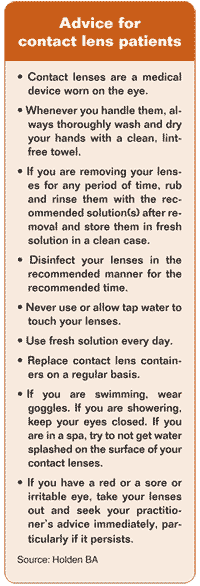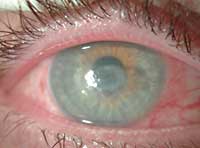Compliance, environment risk factors for infections
With Acanthamoeba and Fusarium keratitis outbreaks making the news, one thing has become clear to many practitioners: It’s time to get serious about talking to patients about the risks of developing contact lens-related infections.
“Contact lenses are a ‘medical device’,” Australian optometrist Brien A. Holden, PhD, DSc, OAM, said. “We have, at the peril of our patients, ‘sold’ them as cosmetic adjuncts without supervision, given the impression that disposables do not need care and generally de-emphasized safety. As an industry, we have not done a good job of encapsulating succinctly the instructions on how to avoid microbial keratitis in a user friendly form.”
Prof. Holden and other optometrists talked to Primary Care Optometry News about the risks of developing contact lens-related infections, primarily patient compliance, environmental factors and solutions.
Types of infections
“The vast majority of infections are going to be bacterial in contact lens wearers,” Joseph P. Shovlin, OD, FAAO, in private practice in Scranton, Pa., told PCON. Dr. Shovlin recently co-authored a report on assessing and managing bacterial keratitis in patients who wear contact lenses.
|
Image: Tu E |
“Contact lenses are a risk factor for any type of corneal infection,” he said. “There are hotbeds around the country of unusual pathogens such as fungal and protozoan infections. For example, the risk for fungal keratitis is much greater in warmer climates, in particular, South Florida and other areas in the deep South.”
Methicillin-resistant Staphylococcus aureus infections appear to be on the rise as well in certain parts of the country, according to Dr. Shovlin.
Infections in contact lens wearers have the potential to cause significant corneal morbidity including vision loss. Because of that, obtaining a patient’s history, assessing his or her risk factors and being aware of the different clinical presentations can help a practitioner make the appropriate diagnosis and manage the infection.
“Are we clinically scraping more patients with contact lens infiltrates? Yes, in general, most clinicians will, rather than just simply treat them empirically,” Dr. Shovlin continued. “Any suspicious infiltrate will be cultured on blood, chocolate and Sabouraud’s media. Of course, if there is some concern about a protozoan infection, that diagnosis is best made in a timely fashion as well for imparting better cure rates.
“If you’re suspicious for Acanthamoeba, you want to use a culture plate of Escherichia coli overlay, and you can also do some immunofluorescence testing as well, but you usually have to send those to special labs,” Dr. Shovlin continued.
The environment’s influence
The environment appears to play a huge role in encouraging organisms to proliferate.
“Some environmental risks we just don’t fully understand,” Dr. Shovlin said. “I’m not suggesting that there’s an environmental shift in organisms, but I think we need to look at that potential. In other words, are these things surviving better than they have in the past because of what we’re doing in an environmental fashion, for example, dropping the chlorine and trihalomethane levels (in municipal water supplies)?”
Charlotte E. Joslin, OD, FAAO, an assistant professor at the University of Chicago, Department of Ophthalmology and Visual Sciences and PhD candidate in epidemiology, is conducting research on environmental risk factors, especially water sources, with her colleague Elmer Tu, MD, director of the department’s Cornea and Refractive Surgery Service.
Dr. Joslin’s research focuses primarily on Acanthamoeba keratitis.
“Because Acanthamoeba is an organism ubiquitous in the environment and present in both untreated and treated water, it is possible that environmental sources may contribute to disease; as such, it is reasonable to have patients avoid exposing their contact lenses to untreated or treated water, particularly in light of the ineffectiveness of most multipurpose solutions against Acanthamoeba,” Dr. Joslin said in an interview with PCON. “Research is ongoing to determine the effects of the local water source on the risk for Acanthamoeba keratitis.”
Dr. Joslin went on to say that Acanthamoeba cases in the Chicago area have continued to rise since May 2003. Contact lens care solutions played an integral role, she said, and research to identify other risk factors continues.
“Two independent investigations with separate datasets recently associated Advanced Medical Optics’ Complete MoisturePlus multipurpose solution with Acanthamoeba keratitis, including both our paper published in the American Journal of Ophthalmology in August and the CDC’s Morbidity and Mortality Weekly Report released in June,” Dr. Joslin said. “However, this solution was used by only about 40% of AK cases, suggesting additional risk factors may be important, too. We are currently in the middle of an ongoing study to identify these risk factors.”
No-rub not popular

None of the doctors interviewed for this article were fans of no-rub solutions, which may engender compliance.
“A major source of risk could be the ‘no-rub-and-rinse’ philosophy,” Prof. Holden told PCON. “Rubbing and rinsing lenses that are reused is a critical part of safety, especially for fungus and amoeba. To advocate no-rub is, in my opinion, very risky with any system that relies on the one multipurpose solution.”
“We may see the last of no-rub approvals,” Dr. Shovlin added. “The bulk of pathogens come off with a simple rub and rinse. Things don’t adhere tenaciously to lenses, possibly with the exception of Pseudomonas to certain deposit-prone lenses. Our patients are back to the basics of rubbing and rinsing and disinfecting overnight with multipurpose solutions. The current solutions are pretty effective in providing patients and practitioners with the margin of safety they need.”
For patients who are still concerned about infections, Dr. Shovlin recommends switching to a daily disposable contact lens or a peroxide cleaning system.
Advocating, facilitating compliance
The doctors advocate a return to the basics: educating patients each time they visit about the importance of hygiene, maintaining a proper lens care regimen and using the proper solution.
A simple credit card-sized instruction sheet would be useful for all contact lens wearers, Prof. Holden advised (see sidebar).
“It is critical for every contact lens wearer to understand and comply with these basic rules,” Prof. Holden said. “The vast majority of infections are related to serious high levels of contamination introduced to the eye, either through the case or through the hands, and compliance will help eliminate the risk of microbial keratitis for contact lens wearers. It should not be beyond the capability of the practitioner and the industry to deliver these instructions in a memorable and user-friendly way.
Treatment options
For a serious, sight-threatening contact lens-related microbial infection, Dr. Shovlin said he would culture the infection and then treat it with a loading dose of a newer-generation fluoroquinolone – and a cephalosporin alternately. Once the infection is identified as gram positive or gram negative, he would adjust the medication accordingly.
For a fungal infection, he would use a shotgun approach of topical natamycin and voriconazole topically and orally.
“With Acanthamoeba infections, we will often start with monotherapy, and it would be one of the biocides – either chlorhexidine or one of the biguanides, such as Baquacil [Zeneca] to measure toxicity. Brolene [propamidine isethionate 0.1%, Aventis] should be added in severe keratitis,” Dr. Shovlin said.
For more information:
- Brien A. Holden, PhD, DSc, OAM, is a scientia professor at the University of New South Wales and head of the Institute for Eye Research. He can be reached at Level 4, Rupert Myer Bldg., University of New South Wales, NSW Sydney 2052 Australia; (61) 2-9385-7418; fax: (61) 2-9385-7401; e-mail: b.holden@ier.org.au. Prof. Holden has no direct financial interest in any of the products mentioned in this article, and he is not a paid consultant for any of the companies mentioned. His organization gets royalties on the sales of O2Optix and his institute has research contracts with CIBA Vision, Alcon and intellectual property arrangements with Vistakon.
- Joseph P. Shovlin, OD, FAAO, is a Primary Care Optometry News Editorial Board member who practices at Northeastern Eye Institute in Scranton, Pa. He can be reached at 200 Mifflin Ave., Scranton, PA 18503; (570) 342-3145; fax: (570) 344-1309; e-mail: jpshovlin@gmail.com. Dr. Shovlin has no direct financial interest in any of the products mentioned in this article, and he is not a paid consultant for any of the companies mentioned.
- Charlotte E. Joslin, OD, FAAO is an assistant professor at the University of Illinois at Chicago, Department of Ophthalmology and Visual Sciences and a PhD candidate in epidemiology at the UIC School of Public Health. She can be reached at 1855 W. Taylor St., Ste. 3.164, Chicago, IL 60612; (312) 996-5410; fax: (312) 996-4255; e-mail: charjosl@uic.edu. Dr. Joslin has no direct financial interest in any of the products mentioned in this article, and she is not a paid consultant for any of the companies mentioned.
References:
- Bryant K, Bugante J, Chant T et al. Acanthamoeba keratitis multiple states, 2005—2007. MMWR. Available at: http://www.cdc.gov/mmwr/preview/mmwrhtml/mm5621a4.htm. Accessed August 8, 2007.
- Joslin CE, Tu EY, McMahon TT et al. Epidemiological characteristics of a Chicago-area Acanthamoeba keratitis outbreak. Am J Ophthalmol. 2006;142(2):212-217.
- Joslin CE, Tu EY, Shoff ME et al. The association of contact lens solution use and Acanthamoeba keratitis. Am J Ophthalmol. 2007;144(2):169-180.
- Schein OD, McNally JJ, Katz J et al. The incidence of microbial keratitis among wearers of a 30-day silicone hydrogel extended-wear contact lens. Ophthalmology. 2005;112(12):2172-2179.

